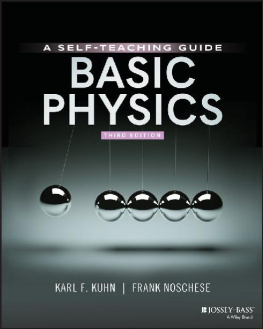Karl F. Renk - Basics of Laser Physics
Here you can read online Karl F. Renk - Basics of Laser Physics full text of the book (entire story) in english for free. Download pdf and epub, get meaning, cover and reviews about this ebook. year: 0, publisher: Springer International Publishing, Cham, genre: Computer. Description of the work, (preface) as well as reviews are available. Best literature library LitArk.com created for fans of good reading and offers a wide selection of genres:
Romance novel
Science fiction
Adventure
Detective
Science
History
Home and family
Prose
Art
Politics
Computer
Non-fiction
Religion
Business
Children
Humor
Choose a favorite category and find really read worthwhile books. Enjoy immersion in the world of imagination, feel the emotions of the characters or learn something new for yourself, make an fascinating discovery.
- Book:Basics of Laser Physics
- Author:
- Publisher:Springer International Publishing, Cham
- Genre:
- Year:0
- Rating:3 / 5
- Favourites:Add to favourites
- Your mark:
Basics of Laser Physics: summary, description and annotation
We offer to read an annotation, description, summary or preface (depends on what the author of the book "Basics of Laser Physics" wrote himself). If you haven't found the necessary information about the book — write in the comments, we will try to find it.
Karl F. Renk: author's other books
Who wrote Basics of Laser Physics? Find out the surname, the name of the author of the book and a list of all author's works by series.













 1 femtosecond
1 femtosecond  s). The field of a pulse train is spatially and temporally coherent too.
s). The field of a pulse train is spatially and temporally coherent too. 1 millisecond
1 millisecond  10
10  s
s s
s  1 microsecond
1 microsecond  10
10  s
s 1 nanosecond
1 nanosecond  10
10  s
s 1 picosecond
1 picosecond  10
10  s
s 1 femtosecond
1 femtosecond  10
10  s
s 1 attosecond
1 attosecond  10
10  s
s device for generation of coherent electromagnetic waves by stimulated emission of radiation. The maser (
device for generation of coherent electromagnetic waves by stimulated emission of radiation. The maser (  microwave laser ) makes use of microwave amplification by stimulated emission of radiation.
microwave laser ) makes use of microwave amplification by stimulated emission of radiation. of an electromagnetic wave in vacuum obeys the relation
of an electromagnetic wave in vacuum obeys the relation 
 m s
m s  ) is the speed of light and
) is the speed of light and  the wavelength. Abbreviations of frequencies are as follows:
the wavelength. Abbreviations of frequencies are as follows:  1 megahertz
1 megahertz  10
10  Hz
Hz 1 gigahertz
1 gigahertz  10
10  Hz
Hz 1 terahertz
1 terahertz  10
10  Hz
Hz 1 petahertz
1 petahertz  10
10  Hz
Hz